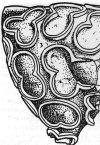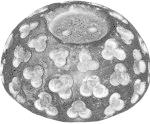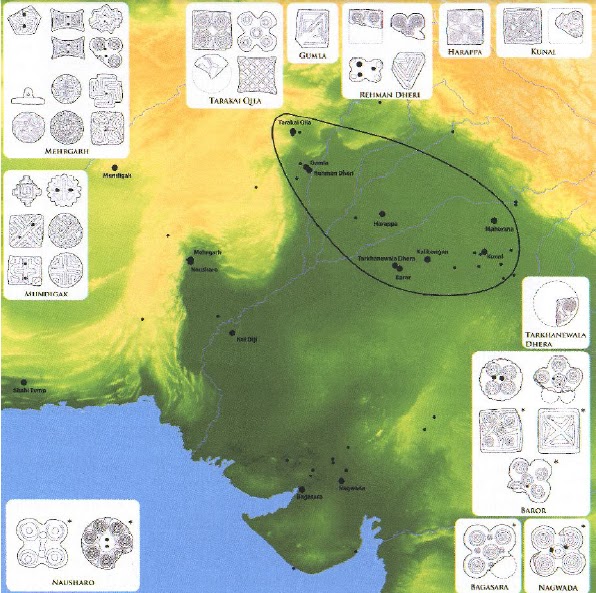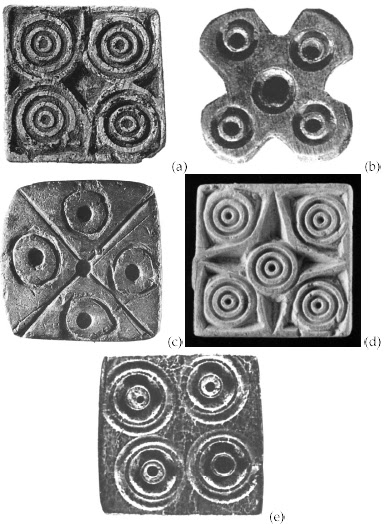A paper was presented by Asko Parpola wherein some examples of Indus writing are cited in relation to cardinal directions, solar disks, astral symbolism denoted by 'trefoil' or 'fish' or 'crocodile' glyphs. See: http://bharatkalyan97.
These examples of 'symbols' used by Asko Parpola have been discussed in the context of decoding many Meluhha epigraphs of Indu script corpora and cuneiform seals etc. from Ancient Near East.
Alternative Meluhha rebus readings are suggested in this note, in addition to the dhokra kamar tablet of Dholavira discussed at http://bharatkalyan97.
Prima facie, it may be far-fetched to see astronomical roots in the types of geometrical patterns depicted in the following examples which could simply be geometrical designs used by the scribe unless the context in which the seals were discovered can be evaluated:
Distribution of geometrical seals in Greater Indus Valley during the early and *Mature Harappan periods (c. 3000 - 2000 BCE). After Uesugi 2011, Development of the Inter-regional interaction system in the Indus valley and beyond: a hypothetical view towards the formation of the urban society' in: Cultural relagions betwen the Indus and the Iranian plateau during the 3rd millennium BCE, ed. Toshiki Osada & Michael Witzel. Harvard Oriental Series, Opera Minora 7. Pp. 359-380. Cambridge, MA: Dept of Sanskrit and Indian Studies, Harvard University: fig.7
Kot Diji type seals with concentric circles from (a,b) Taraqai Qila (Trq-2 &3, after CISI 2: 414), (c,d) Harappa(H-638 after CISI 2: 304, H-1535 after CISI 3.1:211), and (e) Mohenjo-daro (M-1259, aftr CISI 2: 158). (From Fig. 7 Parpola, 2013).
Sun's rays as hieroglyph
The following examples cited, however, can be seen to relate to the depiction of 'sun' or 'sun's rays and can be read rebus:
Hieroglyph: arka ‘sun’; agasāle ‘goldsmithy’ (Ka.) erka = ekke (Tbh. of arka) aka (Tbh. of arka) copper (metal); crystal (Ka.lex.) cf. eruvai = copper (Ta.lex.) eraka, er-aka = any metal infusion (Ka.Tu.); erako molten cast (Tulu) Rebus: eraka = copper (Ka.) eruvai = copper (Ta.); ere - a dark-red colour (Ka.)(DEDR 817). eraka, era, er-a = syn. erka, copper, weapons (Ka.)
Seal from Rahman Dheri with the motif of 'rays around concentric circles'. After Durrani, FA, et al., 1994-95, Seals and inscribed sherds in: Excavations in the Gomal valley: Rehman Dheri report No.2 ed. Taj Ali. Ancient Pakistan 10, Peshawar: Department of Archaeology, University of Peshawar: Pp. 198-223.
'Sun' in 'four quadrants', painted on faiz Mohammad style grey ware from Mehrgarh, period VI (c. 3000-2900 BCE), Kacchi plain, Pakistan. After C. Jarrige et al., 1995, Mehrgarh Field Reports 1974-1985: From neolithic times to the Indus civilization, Karachi: Sind Culture Department: 160.
Trefoil as hieroglyph
Trefoil as hieroglyph presenting some examples is evaluated at http://bharatkalyan97.blogspot.in/2014/01/the-most-vexed-problem-of-indian.html
Rebus readings on the trefoil signifiers which appear in the civilization in the following examples:
1. Shown pota 'cloth' worn as a shawl by the important person, the trefoil hieroglyph can be read rebus as the homonymous word: pōtṛ 'temple priest'.
2. Shown on pota 'young animal or heifer', or on beads, the trefoil hieroglyph can be read either as pot'boat' or pote 'long straight bar of jewelry or bead'.
2. Shown on pota 'young animal or heifer', or on beads, the trefoil hieroglyph can be read either as pot'boat' or pote 'long straight bar of jewelry or bead'.





Finely polished stone pedestal from Mohenjo-daro, decorated with 'trefoil' figures. After Parpola, Asko, 1985, The sky garment: a study of the Harappan religion and its relation to the mesopotamian and later Indian religions. Studia Orientalia, 57. Helsinki: The Finnish Oriental Society: fig. 91.
Fish, crocodile as hieroglyphs
Fish and crocodile as hieroglyphs are evaluated at http://bharatkalyan97.blogspot.in/2014/01/meluhha-hieroglyphs-snarling-iron-of.html
The Meluhha rebus readings are:
kāru 'crocodile' (Telugu) Rebus: khar ‘blacksmith’ (Kashmiri); kāru ‘artisan’ (Marathi)
ayo 'fish' Rebus: ayas 'metal'.
In some cases, fish is shown as caught in the jaws of a crocodile. This set of hieroglyphs is read rebus as: ayakāra‘ironsmith’ (Pali)[fish = aya (G.); crocodile = kāru (Te.)]
Seal H-9 from Harappa with the sign sequence "7" + "fish". After CISI 1:166.
Horizontal crocodiles set on vertical poles, Mature Harappan painted pot from Amri, Sindh, Pakistan. After Casal, Jean-Marie, 1964, Fouilles d'Amri, 2 vols. Publications de la Commission des Fouilles Archeologique: Fouilles du Pakistan. Paris: C. Klincksieck: II, fig 75, no. 323.
Hieroglyphs: 'fig tree' + 'fish' on Seal M-414 from Mohenjo-daro. After CISI 1:100.
Meluhha rebus readings:
kamaḍha = ficus religiosa (Skt.); kamar.kom ‘ficus’ (Santali) rebus: kamaṭa = portable furnace for melting precious metals (Te.); kampaṭṭam = mint (Ta.) Vikalpa: Fig leaf ‘loa’; rebus: loh ‘(copper) metal’. loha-kāra ‘metalsmith’ (Sanskrit).
ayo 'fish' Rebus: ayas 'metal'.
Hieroglyph Ka. koṇḍi the sting of a scorpion. Tu. koṇḍi a sting. Te. koṇḍi the sting of a scorpion.(DEDR 2080). Rebus: kuṇḍī = chief of village. kuṇḍi-a = village headman; leader of a village (Pkt.lex.) i.e. śreṇi jeṭṭha chief of metal-worker guild. khŏḍ m. ‘pit’, khö̆ḍü f. ‘small pit’ (Kashmiri. CDIAL 3947), kuṭhi‘smelter furnace’ (Mu.) kuṇḍamu ‘a pit for receiving and preserving consecrated fire’ (Te.) kundār turner (A.); kũdār, kũdāri (B.); kundāru (Or.); kundau to turn on a lathe, to carve, to chase; kundau dhiri = a hewn stone; kundau murhut = a graven image (Santali)
In summary, it may be said that while Asko Parpola has presented a remarkable array of references from ancient Indian tradition, most of the references are unrelated to the Meluhha epigraphs. It can only be a matter of faith that one can read astronomy in the artifacts presented in an elaborate monograph of Asko Parpola.
Parpola's reading of crocodile cult in the Dholavira tablet showing the hieroglyph, dhokra'a decrepit person' ligatured to the back (kamar) of a bovine, I have suggested that the hieroglyphs relate to the work of dhokra kamar whose artisanal competence in making artifacts is seen in the bronze dancing girl of Mohenjo-daro made using lost-wax technique. Such a technique in Indian sprachbund vernacular is called dhokra.
Sarasvati Research Center
January 30, 2014








